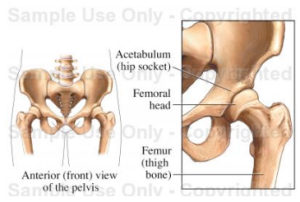Platelet Rich Plasma is gaining significant notoriety, and more and more uses are being found almost daily. PRP has been incredibly successful when used in large joints for restoration and retardation of the degenerative process.

|
Hip Degeneration can be related to Osteoarthritis, as in this case.
Osteoarthritis is a degeneration or ‘wear and tear’ of articular (joint surface) cartilage usually accompanied by an overgrowth of bone (osteophytes), narrowing of the joint space, sclerosis or hardening of bone at the joint surface, and deformity in joints.
The hip joint is one of the larger joints in the body, and the numbers of surgical interventions, and hip degeneration is staggering.
Between 200,000 and 300,000 hip replacement operations are performed in the United States each year, most of them in patients over the age of 60. According to the American Academy of Orthopedic Surgeons (AAOS)
Some very important statistics to keep in mind regarding Hip OA:
Radiographic OA — prevalence per 100!
Hip = 1.5 (1.4 female; 1.4 male)
Symptomatic OA — prevalence per 100!
Hip = 4.4% (3.6% female; 5.5% male) ! ! adults ≥55 years of age
Incidence
Hip OA = 88 per 100,000 person years
Knee and hip joint replacement procedures accounted for 35% of total arthritis-related procedures during hospitalization.
Cost $7.9 billion estimated costs of knee and hip replacements in 2007.
Average direct costs of OA ~$2,600 per year out-of-pocket expenses. Total annual disease costs = $5700
Job-related OA costs $3.4 to $13.2 billion per year
PATIENT CASE
This the case of a 65 year old female with a diagnosis of left hip Degenerative joint disease, and previous history of the contralateral hip undergoing hip replacement 5 years prior.
Her post operative course was a prolonged and bumpy one, suffering from several different poor reactions to pain medications, and having an uncomfortable hospital stay . She came to see us for consideration of treatments to hopefully avoid the surgery on the right side.
READY TO FIND A PRP DOCTOR? |
We have partnered with PRP doctors in your area! |
In discussing her prior interventions, she underwent the usual course of oral NSAID therapy, physical therapy, and multiple corticosteroid injections into the hip. Although she states she did receive some benefit from these interventions, the relief was invariably transient with each injection. Moreover, rightfully so, she was becoming concerned about potential side effects of multiple steroid injections.
After a thorough history and physical examination , we elected to move forward with PRP therapy. Additionally, I elected to perform this procedure for her under live fluoroscopy ( x-ray) to ensure precise placement of the platelets.
After appropriate preparation, the right hip was visualized, and a 20 gauge needle was placed into the anterior aspect of the joint.
As you can see, contrast dye is indicated under fluoroscopy to ensure precise placement. As a side note, there are may different types of contrast, so working around patient allergies should not be an issue.
Once confirmation of placement of the needle was confirmed, the prepared PRP aliquot was obtained in a sterile fashion, and then injected in a slow methodical, and uniform fashion with intermittent aspiration until the process was completed.
We elected to use 60cc of blood, which generated 10cc of PRP. The patient reported only minimal discomfort during the procedure. Additionally, she had the procedure performed under local anesthesia only.
Upon follow up one month later, she reported significant improvement in ROM and pain levels. Her pre – injection pain scores were 9-10/10, and only one month later she reported 6-7/10.
We performed 2 subsequent PRP injections for her, and her overall pain dropped to 4-5/10.
She continues to experience pain improvement, an increase in physical activity level, and also a decrease in her overall pain medication usage. To date, she has not required surgical intervention either! So, we have treated her with a minimally invasive, conservative, restorative intervention that has had a host of positive changes in her life thus far, and I look forward to her continued progress.
Akash Bajaj MD, MPH
Medical Director
Remedy Pain Solutions
Marina del Rey, CA
Double Board Certification: Anesthesiology and Pain Management
Current Fellow of American Board of Anti Aging Medicine
NEED HELP FROM A DOC? |
Our partner clinics are ready to serve you! |



